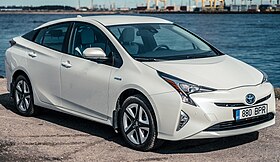
Back معمارية تويوتا العالمية الجديدة Arabic Toyota New Global Architecture German TNGA-pohjalevy Finnish Plate-forme Toyota TNGA French Toyota New Global Architecture ID トヨタ・ニュー・グローバル・アーキテクチャー Japanese 토요타 뉴 글로벌 아키텍처 Korean Toyota New Global Architecture Polish Toyota New Global Architecture Russian สถาปัตยกรรมยานยนต์ใหม่ของโตโยต้า Thai
| Toyota New Global Architecture | |
|---|---|
 Fourth-generation Toyota Prius, the first vehicle to use the Toyota New Global Architecture platform | |
| Overview | |
| Manufacturer | Toyota |
| Also called | TNGA |
| Production | 2015–present |
| Body and chassis | |
| Platform |
|
| Chronology | |
| Predecessor |
|
The Toyota New Global Architecture (abbreviated as TNGA) is a modular automobile platform that underpins various Toyota and Lexus models, starting with the fourth-generation Prius in late 2015.[1] TNGA platforms accommodate different vehicle sizes and also front-, rear-, and all-wheel drive configurations.[2]
The platforms were developed as part of a company-wide effort to simplify the vehicles being produced by Toyota. Before the introduction of the TNGA, Toyota was building roughly 100 different platform variants.[3] As of 2020[update], the five TNGA platforms underpin more than 50% of Toyota vehicles sold worldwide and is expected to underpin about 80% by 2023.[4]
Each platform is based on a standardized seat height that allows for sharing of key interior components such as steering systems, shifters, pedals, seat frames and airbags.[5] These components are often less visible, allowing for cars that share platforms to have unique interiors. Compared to Toyota's older platforms, TNGA costs 20 percent less to produce while offering increased chassis stiffness, lower centers of gravity for better handling and lower hood cowls for better forward visibility.[3]
The TNGA platform was developed alongside the Dynamic Force engine, which similarly is replacing more than 800 engine variants with a much simpler lineup of 17 versions of nine engines.[3] Toyota is also simplifying its lineup of transmissions, hybrid systems, and all-wheel drive systems.
- ^ Stocklosa, Alexander (27 March 2015). "Cowa-TNGA! Toyota's New Modular Platform Reaching Production This Year". Car and Driver. Retrieved 5 August 2016.
- ^ Akita, Masahiro (11 March 2013). "Opportunities and risks related to parts sourcing for next-gen Prius". Credit Suisse. pp. 1–3. Archived from the original on 17 July 2014.
- ^ a b c Reynolds, Kim (7 May 2015). "How the Toyota New Global Architecture Will Impact Mass-Car Building". Motor Trend. Retrieved 24 August 2020.
- ^ "Features of Toyota's New Powertrain". Toyota Motor Corporation. Retrieved 24 August 2020.
- ^ Lin, Kelly (27 March 2015). "Toyota New Global Architecture to Debut This Year, Likely on the New Prius". Motor Trend. Retrieved 24 August 2020.